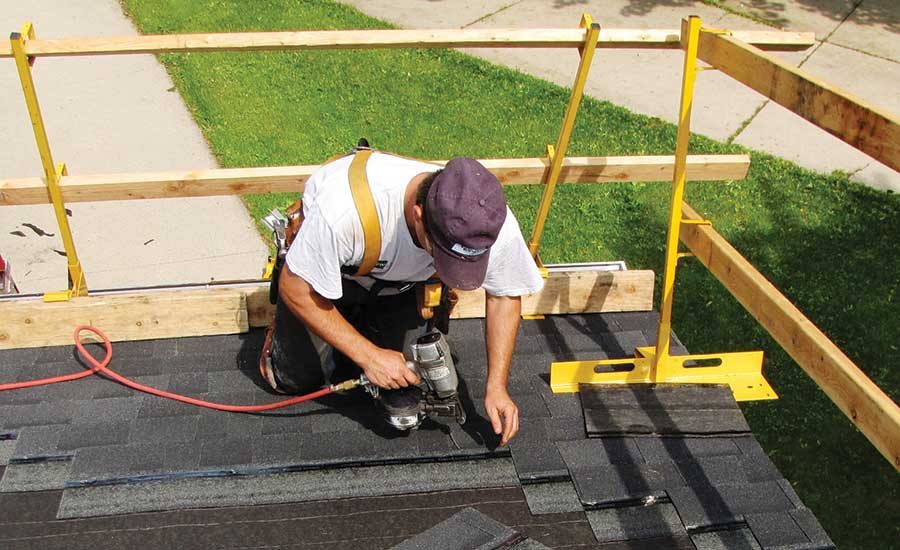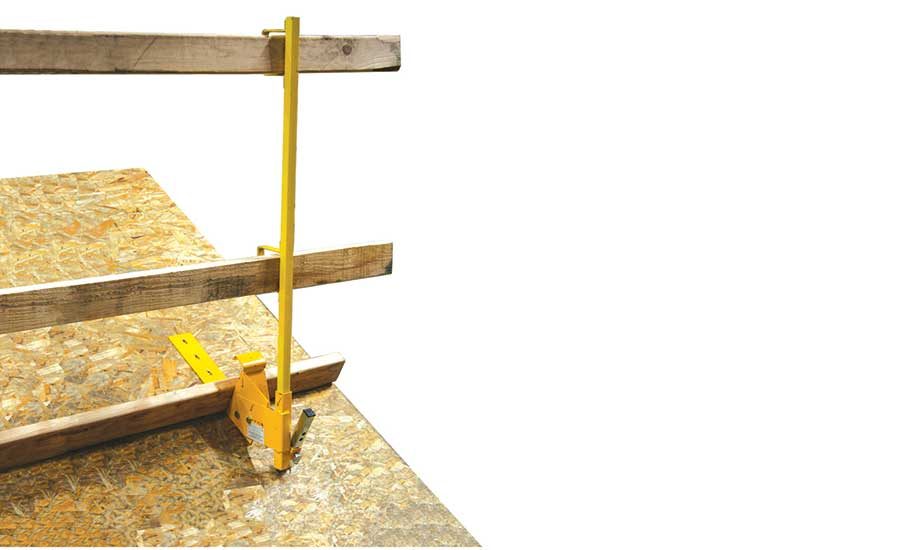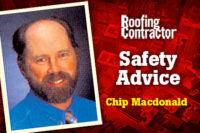Roof Safety: Roof Guardrails (Revisited)
Roof guardrails systems appeard to be the future of worker safety. Why haven't they still taken hold?

When it comes to totally eliminating all fatal falls from roofs, fall prevention (guardrails and restraint) certainly takes precedence over fall protection (PFAS and safety nets).

When it comes to totally eliminating all fatal falls from roofs, fall prevention (guardrails and restraint) certainly takes precedence over fall protection (PFAS and safety nets).


Almost five years ago, I investigated and reviewed Steep-Pitched Roof Guardrail Systems (SPRGS) manufactured at that time to serve the residential roofing market for Roofing Contractor. In my conclusion, I wrote: “I believe within the coming years, the steep roof guardrail system could become the fall protection system of choice for most residential roofing contractors.”
Like working live on stage with children and animals, it’s always risky to predict an outcome. I was never-the-less convinced that my research and logic would reflect a predictable trend. When it comes to totally eliminating all fatal falls from roofs, fall prevention (guardrails and restraint) certainly takes precedence over fall protection (PFAS and safety nets). I still believe preventing the fall from ever occurring beats the 1,800 ft./lb. terminal impact force of an arrested fall every time. I still also believe that it can be the superior cost-saving solution as well.
Using Any Fall Protection
I now realize my crystal ball failed to account for three qualifying factors: 1) the limited and politicized nature of OSHA’s Residential Fall Protection enforcement policy; 2) the building contractor’s resistance to recognizing a real threat to his employees; and 3) the inherent stubborn nature of the “aerial trades” to implement change. These three factors are rarely discussed in public forums, but are common knowledge among workers gathered around the canteen truck on the jobsite.
Please don’t misunderstand me. Since it was fully authorized in 1970 to inspect, adjudicate and enforce its standards, OSHA has undoubtedly saved and improved thousands, if not millions, of worker’s lives. In my opinion, however, it’s evolved into a top-heavy, federal bureaucracy 48 years later. Working under the U.S. Dept. of Labor (DOL) throughout the last nine presidential administrations, it employs more than 2,000 inspectors and administrators, with a dismal worker-to-inspector ratio of almost 60,000/1. The agency employs hundreds of elected and appointed administrators with both local and federal agendas and favors owed behind closed doors. District and local directors are often handcuffed by fluid policy interpretations handed out from above them in the food chain. Often the agency’s interpretations, actions and budget allocations are manipulated by “watercooler recommendations” from the DOL, or edicts from the Oval Office. Without much argument, we can all agree that the agency and bureaucrats overseeing them are certainly not the same as they were in 1968.
Republican President Richard Nixon was elected with only a 1 percent popular vote majority over Democrat Hubert Humphrey and yet during in his second administration, he signed the OSH Act of 1970 into law. Today it wouldn’t even reach the floor for debate, let alone make it all the way to committee. While legislators may have increased OSHA’s annual budgets since 1970, they’ve also reduced the percentage of available funds to perform field inspections, prioritizing outreach and training programs. Fewer inspections result in fewer hazardous violations identified, fewer employer citations and lower penalties. As a result, fall-from-heights continues to lead in construction fatality rates. It’s been my experience that fewer citations never results in greater compliance. Fatal falls in construction will continue to rise for the foreseeable future unless lawmakers join bilaterally to eradicate falls-from-heights as they did for reducing worker’s exposure to asbestos, silica and radium on the job 40 years ago.
Everyone agrees that the advent of OSHA’s personal protective equipment (PPE) standards has protected millions of workers from injury, illness and death. However, because PPE is designed to ANSI’s failure-based testing methods, it also allows those deadly hazards to approach within mere inches of the worker’s body. This factor alone relegates PPE-based solutions of full-body harness, shock-absorber lanyard and anchoring system to the third position in the hazard abatement lineup, behind administrative and engineering controls, such as guardrails. Even relative PPE compliance in the construction trades, compared to General Industry, is dismally low and the use of PFAS has gained much less popularity among most elevated workers than the hard hat, safety glasses and even respirator usage in recent years. Most evident is the fact that the leading category in OSHA’s Fatal Four has always been falls from heights each year since it began tracking statistics. The numbers show that the fatality rate for construction workers in 2015 reached 10.1 deaths /100,000 workers. Falls from heights in 2015 accounted for 39 percent of the root cause in those worker’s deaths. They also accounted for 75 percent of all roofer deaths in the U.S. In the same year, the construction industry’s fatality rate ranked fourth among all industries, yet it had the highest total number of worker deaths (937), a 4 percent increase from 2014.
The roofing trade’s fatality rate ranked fourth behind loggers, commercial fishermen and commercial pilots. Not only are the construction trade’s total fatalities higher than all but three other occupations, they continue to rise in both rate and total deaths every year, while other occupation’s rates have plateaued or fallen.
When it comes to the “aerial trades” such as roofers, ironworkers, linemen, and bridge workers, they share a common denominator with the other three ‘deadliest’ trades — they’re typically independent or sub-contractors, working in remote areas and therefore less likely to receive the frequent supervision or skilled auditing required from their prime contractors. An incompetently-supervised workforce typically results in a higher fatality rate and an increase in total deaths resulting from falls. Since 1983 my study of occupational safety on-the-job has shown me that all of the Federal emphasis policies and nation-wide “stand-down for safety” programs simply amount to status-quo until the day the federal government declares complete annihilation of the number one killer of construction workers. I count over a hundred roofing violations in plain sight every year during my travels. Going back to enforcement, imagine how many one could spot if that was their full-time job.
Fall Prevention Hierarchy
Personal Fall Arrest Systems (PFAS) and safety nets permit the worker to fall, then arrest that fall with an ANSI-rated maximum terminal impact force (TIF) of 1,800 ft./lb. Once finally arrested in a Class III harness, the PPE that initially saved the worker from severe injury or death, is now restraining them in a potentially lethal, erect postural position called orthostasis. With gravity, any prolonged orthostasis of about 15 minutes may initiate the often-fatal onset of a fainting cycle, as well as other serious physical threats. Unfortunately, many arrested falls don’t occur in convenient or even accessible locations. Many rural or suburban fire departments and emergency responders outside of large municipalities are not always adequately NFPA-trained or qualified to provide high angle rope rescues. Without adequate preparation, a “simple” fall accident may add significant costs and schedule delays at the least and injury or death at the worst. Even after a safe fall arrest event using fall protection, many workers are still injured and unavailable to work. For the employer, this can mean lost time, additional administrative cost and the potential risk of litigation from injured employees. In comparison, it’s extremely rare that an at-height accident involving a compliant guardrail system that results in a worker’s death or critical injury requires rescue. The use of a guardrail system on a sloped roof clearly mitigates the risk of death and injury for the roofer, while dramatically reducing the fiscal losses and liability for the employer who’s “duty to protect” is clearly stipulated by OSHA.
A Cost-Benefit Analysis
During my 2013 research into roof guardrails, I reassessed the cost of several residential roofing jobs (4:12 Ranch; 12:12 Gable and 8:12 Hip) I had previously estimated, bid and supervised. I compared the cost and schedule of the PFAS system I used to a proposed guardrail system on the same roofs. As most of my roof staging and access equipment during my time as a contractor and safety trainer were primarily manufactured by ACRO Building Systems, I selected ACRO’s Steep Pitch Guardrail System for my simulation. These guardrails structurally anchor to rafters and deck and interleaf with the shingle courses on top of the roof, rather than attaching to the rafters or fascia from below, as with other manufacturers.
There are two ACRO steep roof guardrail configurations: An eave bracket and post (@12 lbs); and a rake bracket and post (@15 lbs) to be secured to the deck framing at 6-8 feet on-center. In 2013, I set up a 10:12 pitch roof simulation at grade in order to experiment with assembly times at a working height 3 ft below eave (comparable to pump jack scaffold plank elevations). All my equipment was staged within my reach, presuming I had a laborer assisting me from grade below. After practicing multiple eave/rake set-ups, I recorded my best elapsed assembly time. By dividing this time by the linear distance of the guardrail built, I came up with a conservative assembly rate between rake and eaves of about two minutes per linear foot of guardrail protected roof edge. I estimated that installing guardrails on a simple gable roof at 10/12 pitch with a total of 80 linear feet of eave and 96 linear feet of rake would take one experienced roofer and one laborer between five and six hours (including deck preparation) to assemble, or 10-12 man-hours. Adding the installation of a temporary PFAS, I concluded it would take two men approximately 6-7 hours to complete the guardrail system for a 24-square roof. As with anything new, consistent practice with workers willing to learn will always improve efficiency and increase productivity. So, if we can all agree that: 1) OSHA considers a passive engineering control is superior to PFAS; and 2) there is a significant cost benefit to installing guardrail systems, why don’t we see a dramatic increase in the sales and use or roofing guardrail systems?
Current Trends
Charles Henika, director of sales and marketing for ACRO Metal Stamping, said that while not a precise indicator of national retail sales and field use, his figures should be a good indicator of the general popularity of guardrails in the roofing industry over the past sixteen years.
He said ACRO’s average roof guardrail sales from 2001 to 2010 was 3,492 per year, including a 3-year construction economy slow-down from 2008 to 2010. Aside from 2011 — the year that OSHA implemented a new directive for residential fall protection where sales spiked — sales have averaged 4,052 per year, only a 16 percent increase. I would’ve expected dramatic increases in sales after 2011, but that hasn’t happened.
“This product is still only used by a very small segment of the contractor population and I’d say half the contractors that we talk to still don’t know there is an acceptable alternative to using harnesses. Education is still the key,” Henika said.
The ANSI-standard-based personal fall arrest system first became OSHA-regulated in 1998. After almost twenty years, total fall standard compliance by the majority of roofers that I encounter remains poor. Non-compliance, inadequate training and insufficient supervision by a competent person, have led to an increase in construction fatal falls. I also suspect that the introduction of a whole new method to prevent falls from occurring in the first place won’t happen quickly or without resistance within the building trades. And yet despite the three aforementioned arguments against roof guardrail systems, the economic evidence still convinces me that they’ll eventually become the future tool for fall protection for roofing contractors, large and small.
Looking for a reprint of this article?
From high-res PDFs to custom plaques, order your copy today!









